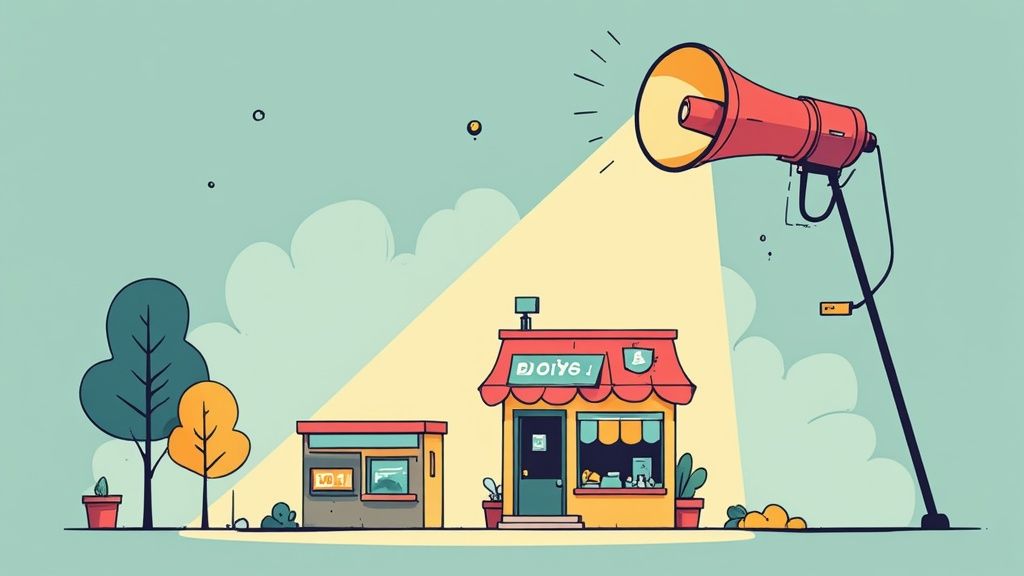Running a small business is a masterclass in multitasking, but mastering marketing can feel like a separate, full-time job. Many entrepreneurs face significant hurdles that can make growth feel like an uphill battle. These aren’t just minor roadblocks; they are the common small business marketing challenges that can stifle potential, from tight budgets and packed schedules to the ever-shifting digital environment.
However, understanding these obstacles is the first step toward overcoming them. This guide unpacks the most prevalent marketing struggles that small businesses encounter and provides a clear, actionable playbook to turn each one into a growth opportunity. We will move beyond identifying the problems and focus on practical solutions you can implement immediately.
Forget vague theories and generic advice. You will learn specific strategies to maximize a limited budget, create high-quality content efficiently, measure your return on investment accurately, and reach the right audience effectively. We will explore how to build brand awareness from the ground up and stay current with key marketing trends without feeling overwhelmed. Let’s move beyond the struggle and start building a resilient, effective marketing engine for your business.
1. Limited Marketing Budget
One of the most universal small business marketing challenges is navigating a constrained budget. Unlike large corporations with multi-million dollar marketing departments, small businesses must make every penny count. This financial limitation directly impacts the ability to invest in wide-reaching paid advertising, hire specialized marketing agencies, or launch comprehensive, multi-channel campaigns. Competing for attention against bigger players requires a strategic, resourceful, and creative approach rather than simply outspending them.

This challenge forces a shift in perspective from “How much can we spend?” to “How can we get the greatest return on our investment?” The goal is to identify and capitalize on high-impact, low-cost strategies that generate tangible results.
Actionable Strategies for a Limited Budget
Instead of focusing on what you can’t afford, concentrate on maximizing the resources you have.
- Prioritize High-ROI Channels: Don’t try to be everywhere at once. Use analytics to identify which one or two channels drive the most conversions for your business. For a local service business, this might be hyper-targeted Google Ads. For a B2B startup, it could be focused content marketing on LinkedIn. Allocate your limited funds where they will have the most significant impact.
- Embrace Organic Marketing: Content marketing and search engine optimization (SEO) are powerful tools for long-term growth. Creating valuable blog posts, how-to guides, or video tutorials that answer your customers’ questions costs more time than money. Over time, this content can attract consistent, high-quality traffic from search engines without ongoing ad spend.
- Leverage Strategic Partnerships: Team up with non-competing local businesses that share your target audience. For example, a new gym could partner with a local health food store for a joint promotion. This cross-promotion allows both businesses to access a new customer base for a fraction of the cost of traditional advertising. This approach builds community trust and expands your reach authentically.
2. Lack of Marketing Expertise
Another significant hurdle for entrepreneurs is the lack of marketing expertise. Most small business owners are experts in their specific craft, whether it’s baking artisanal bread, providing financial advice, or developing software. However, this passion and skill rarely extends to the complexities of digital marketing, consumer behavior analysis, or strategic campaign planning. This knowledge gap can lead to ineffective marketing efforts, wasted resources, and missed growth opportunities.

This particular one of the small business marketing challenges isn’t about not caring; it’s about not having the specialized training to navigate an ever-changing landscape. The challenge is to bridge this gap without needing a formal marketing degree, empowering owners to make informed decisions that drive real business results.
Actionable Strategies for Building Expertise
Instead of feeling overwhelmed by what you don’t know, focus on building your knowledge strategically and incrementally.
- Master One Channel at a Time: Don’t try to learn SEO, social media, email marketing, and PPC all at once. Pick one platform where your target audience is most active and commit to mastering it. For a visual brand like a boutique clothing store, this might mean becoming an expert on Instagram Reels. Once you’ve achieved proficiency and see results, you can branch out to the next channel.
- Invest in Accessible Education: You don’t need a four-year degree to become a competent marketer. There are countless high-quality, affordable online courses on platforms like Coursera, HubSpot Academy, and Udemy. These resources can teach you specific skills, from running Google Ads to understanding analytics, allowing you to learn what you need, when you need it.
- Leverage Freelance Specialists: You don’t have to hire a full-time marketing manager to gain expertise. For specific, high-impact projects, consider bringing in a freelance consultant. Hiring a specialist for a one-time SEO audit or to set up an email marketing automation sequence can provide immense value and a framework you can manage moving forward. For a deeper dive into this approach, explore the benefits of outsourcing marketing for your small business.
3. Time Constraints
For small business owners, time is arguably the scarcest resource. Juggling operations, finance, human resources, and customer service leaves precious little time for marketing. This is a significant entry on the list of small business marketing challenges because consistent marketing requires dedicated effort. When time is fragmented, marketing becomes sporadic and reactive- a contractor neglects website updates for months, or a salon owner posts on social media irregularly, failing to build momentum.

This challenge isn’t about a lack of desire but a lack of hours in the day. Effective marketing often takes a backseat to immediate operational fires, preventing the development and execution of a long-term strategy that drives sustainable growth. The key is to work smarter, not harder, by implementing efficient systems.
Actionable Strategies for Overcoming Time Constraints
Instead of letting marketing fall to the bottom of the to-do list, integrate it into your workflow with smart, time-saving tactics.
- Batch and Schedule Content: Dedicate a single block of time each week or month to “batch” your marketing content. In one four-hour session, you can write several social media posts, draft two email newsletters, and outline a blog post. Use scheduling tools like Buffer or Later to automate the publishing process, ensuring a consistent presence without daily effort.
- Leverage Marketing Automation: Use technology to handle repetitive tasks. Set up automated email sequences to welcome new subscribers or follow up on abandoned carts. Use chatbots to answer common customer questions on your website 24/7. This frees you up to focus on high-level strategy rather than manual execution. Learn more about effective marketing workflow management on reachlabs.ai.
- Focus on High-Impact Activities: You don’t need to do everything. Identify the one or two marketing activities that generate the most results and focus your limited time there. If most of your leads come from local networking events, dedicate time to that and worry less about growing a TikTok following. This 80/20 approach ensures your time investment yields the greatest possible return.
4. Measuring Marketing ROI
One of the most frustrating small business marketing challenges is investing time and money into campaigns without knowing what’s actually working. Small businesses often lack the sophisticated analytics tools and dedicated staff to accurately track and measure the return on investment (ROI) of their marketing efforts. This makes it difficult to distinguish effective strategies from wasted spend, hindering budget optimization and sustainable growth. Without clear data, marketing decisions are based on guesswork rather than evidence.

This challenge transforms marketing from a strategic investment into a high-stakes gamble. The goal is to move beyond vanity metrics like likes and impressions and focus on data that directly links marketing activities to business outcomes, such as leads, sales, and customer lifetime value.
Actionable Strategies for Measuring Marketing ROI
Instead of flying blind, implement simple yet powerful tracking systems to gain clarity on your performance.
- Establish Key Performance Indicators (KPIs): Before launching any campaign, define what success looks like. For an e-commerce store, this might be conversion rate and average order value. For a B2B service provider, it could be the number of qualified leads generated from a contact form. Having clear KPIs provides a benchmark against which all efforts can be measured.
- Implement Foundational Tracking Tools: You don’t need an enterprise-level platform to start. Set up Google Analytics with specific goals, such as form submissions or “add to cart” clicks. Use UTM codes (unique tracking parameters in your URLs) for different campaigns, allowing you to see exactly which social media post, email, or ad drove traffic and conversions.
- Connect Marketing Actions to Sales: Utilize a simple Customer Relationship Management (CRM) system, many of which offer free or low-cost tiers. When a lead comes in, ask how they heard about you and log it in the CRM. This directly connects your marketing channels to actual revenue, providing undeniable proof of what works. For more detailed insights, you can explore proven ways to improve marketing ROI on reachlabs.ai.
5. Building Brand Awareness
For a small business, cutting through the noise to establish brand recognition is a monumental task. This is one of the most fundamental small business marketing challenges because you are often competing in crowded markets against established players with deep pockets and years of brand equity. Whether you’re a local coffee shop up against Starbucks or a tech startup vying for attention, simply making your target audience aware that you exist is the critical first step toward growth. Without awareness, even the best product or service remains invisible.
This challenge requires a deliberate and consistent effort to build a memorable identity and connect with potential customers on multiple fronts. The goal is to move from being an unknown entity to a familiar, trusted name within your specific niche or community.
Actionable Strategies for Building Brand Awareness
Instead of trying to shout louder than your competitors, focus on building authentic connections and demonstrating value.
- Develop a Consistent Brand Identity: Your brand is more than a logo. It’s your voice, your visual style, and the feeling customers get when they interact with you. Ensure your messaging, color scheme, and tone are consistent across your website, social media, and physical location. This consistency builds familiarity and makes your brand instantly recognizable.
- Focus on Local SEO and Community Involvement: For businesses serving a specific geographic area, local visibility is key. Optimize your Google Business Profile with photos, posts, and by encouraging reviews. Sponsor a local youth sports team, host a workshop, or participate in a community festival. This embeds your brand into the fabric of the community, building trust and word-of-mouth awareness.
- Create Value-Driven Content: Establish your business as an expert in its field. A small tech firm can publish insightful articles on industry trends, while an independent bookstore can create curated reading lists or host author Q&As. This content showcases your expertise, answers potential customer questions, and gives people a compelling reason to engage with your brand long before they are ready to make a purchase.
6. Keeping Up with Digital Marketing Trends
The digital marketing landscape is in a constant state of flux, presenting one of the most persistent small business marketing challenges. New platforms emerge, search engine algorithms shift, privacy regulations change, and consumer behaviors evolve at a breakneck pace. For a small business owner juggling daily operations, staying current with these trends can feel like a second full-time job. What worked six months ago might be ineffective today, making continuous learning and adaptation essential for survival and growth.
This challenge requires a balance between mastering foundational principles and experimenting with emerging opportunities. Falling behind can mean losing visibility, engagement, and market share to more agile competitors who successfully leverage new tools and strategies.
Actionable Strategies for Staying Current
Instead of feeling overwhelmed by every new trend, focus on a sustainable approach to learning and implementation.
- Focus and Master Before Expanding: Resist the urge to jump on every new platform. Concentrate on mastering the one or two channels that are most critical for your business. Once you have a strong, consistent presence on your core platforms, you can strategically test a new one. For example, a retail business that excels on Instagram might cautiously experiment with TikTok, but only after its primary channel is optimized and running smoothly.
- Test New Trends on a Small Scale: When a new trend or feature emerges, like Instagram Reels or AI-powered ad optimization, don’t overhaul your entire strategy. Dedicate a small portion of your time or budget to test it. Run a small-scale experiment, measure the results, and then decide if it’s worth a larger investment. This approach minimizes risk while allowing you to innovate.
- Curate Your Information Intake: You don’t need to read everything. Identify and subscribe to a handful of reputable marketing blogs, newsletters, and podcasts (like Search Engine Journal, ahrefs’ blog, or the Social Media Examiner). Dedicate a few hours each month to catch up on the most significant updates. This curated learning is far more efficient than trying to drink from the firehose of daily marketing news.
7. Creating Consistent, Quality Content
One of the most persistent small business marketing challenges is the relentless demand for fresh, high-quality content. For businesses with small teams, producing a steady stream of engaging blog posts, videos, and social media updates can feel like a full-time job in itself. This struggle isn’t just about finding the time; it’s about consistently generating valuable ideas, maintaining brand voice, and creating professional-level materials that capture audience attention. The pressure to feed multiple channels often leads to burnout or inconsistent, low-impact content that fails to deliver results.
This challenge requires a strategic system, not just more effort. The key is to move from a reactive, “what do we post today?” mindset to a proactive, structured approach that makes content creation manageable and sustainable. The goal is to build a content engine that works for you, not against you.
Actionable Strategies for Consistent Content Creation
Instead of viewing content as a daily chore, build a framework that makes the process efficient and repeatable.
- Develop a Content Calendar: A content calendar is your roadmap. Plan your themes, topics, and formats at least a month in advance. A fitness trainer, for example, could dedicate the first week of the month to nutrition tips, the second to workout tutorials, and so on. This eliminates daily decision-making and ensures a balanced mix of content.
- Repurpose, Don’t Just Create: Maximize the value of every content piece. A single detailed blog post can be repurposed into a dozen other assets. For instance, a consultant’s educational article can be turned into a short video for YouTube, a series of tips for Twitter, a visual infographic for Pinterest, and a detailed carousel for LinkedIn. This strategy multiplies your output without multiplying your workload.
- Batch Your Content Production: Set aside dedicated blocks of time for content creation. Instead of trying to write one post or film one video every day, dedicate a single day to producing a month’s worth of content. This “batching” method helps you get into a creative flow state, maintain consistency in quality and style, and frees up your daily schedule for other critical business tasks.
8. Targeting and Reaching the Right Audience
Casting a wide, generic net is a luxury most small businesses cannot afford. One of the most critical small business marketing challenges is accurately identifying, understanding, and reaching the ideal customer. Without the extensive market research departments of large corporations, pinpointing the right audience can feel like searching for a needle in a haystack. This difficulty directly impacts the effectiveness of ad spend, messaging, and overall campaign ROI.
This challenge means that marketing efforts can easily be wasted on people who will never convert. The key is to move from broad assumptions to data-driven insights, ensuring your message resonates with the individuals most likely to become loyal customers.
Actionable Strategies for Audience Targeting
Instead of marketing to everyone, focus your resources on connecting with the right people who truly need what you offer.
- Develop Detailed Buyer Personas: Go beyond basic demographics. Create semi-fictional profiles of your ideal customers based on your best existing clients. Include their goals, pain points, daily challenges, and where they look for information. For a B2B software company, a persona might detail a “Marketing Manager Mary” who is struggling with lead generation and reads specific industry blogs.
- Utilize Your Own Data: Your current analytics are a goldmine of information. Use Google Analytics to analyze your website traffic, looking at the “Audience” reports to see demographics, interests, and geographic locations of your visitors. This data provides a clear picture of who is already engaging with your brand, helping you find more people like them.
- Run Small-Scale Ad Tests: You don’t need a huge budget to learn about your audience. Use platforms like Facebook Ads or Google Ads to run small, targeted campaigns aimed at different audience segments. For example, an online store selling eco-friendly products could test ads targeting “vegan lifestyle” interests against “sustainability” interests to see which group responds better, allowing for smarter budget allocation in the future.
Top 8 Small Business Marketing Challenges Comparison
| Aspect | Limited Marketing Budget | Lack of Marketing Expertise | Time Constraints | Measuring Marketing ROI | Building Brand Awareness | Keeping Up with Digital Marketing Trends | Creating Consistent, Quality Content | Targeting and Reaching the Right Audience |
|---|---|---|---|---|---|---|---|---|
| Implementation Complexity 🔄 | Moderate – requires creative allocation | High – steep learning curve for non-experts | High – juggling multiple roles affects consistency | High – setting up tracking systems is complex | Moderate – brand building needs sustained effort | High – fast-changing environment requires agility | High – regular, quality content demands planning | Moderate – requires customer insights and segmentation |
| Resource Requirements ⚡ | Low – limited financial resources, reliance on creativity | Moderate – need for education, possible consultants | Low to Moderate – limited time but can use tools | Moderate – tools and analytics needed | Moderate – time, creativity, and some budget needed | Moderate to High – time for trend monitoring and testing | Moderate – time, skills, and tools for content creation | Moderate – access to data and marketing tools required |
| Expected Outcomes 📊 | ⭐⭐ – efficient, focused efforts but limited reach | ⭐⭐ – improved skills can boost long-term results | ⭐ – inconsistent execution may reduce impact | ⭐⭐⭐ – better ROI tracking leads to optimized spend | ⭐⭐ – gradual brand recognition and customer trust | ⭐⭐ – potential competitive edge if trends are leveraged | ⭐⭐ – stronger brand authority and SEO benefits | ⭐⭐ – improved targeting increases conversions |
| Ideal Use Cases 💡 | Small businesses needing cost-effective marketing | Business owners seeking marketing knowledge | Owners multitasking across roles | Businesses needing to justify and optimize marketing | New or local businesses building identity | Businesses adapting to fast digital marketing changes | Businesses aiming for sustained content marketing | Businesses focused on niche or segmented markets |
| Key Advantages ⭐ | 💡 Encourages creativity and ROI focus | 💡 Offers learning and fresh marketing perspectives | 💡 Enhances multitasking and maintains personal touch | 💡 Enables data-driven marketing decisions | 💡 Builds unique identity and community connection | 💡 Gains early advantage on platforms and trends | 💡 Builds lasting assets and trust | 💡 Allows precise, personalized marketing |
From Challenge to Champion: Your Next Steps in Marketing
Navigating the landscape of small business marketing can often feel like an uphill battle. The journey is defined by a distinct set of hurdles, from shoestring budgets and packed schedules to the perpetual struggle of measuring impact and keeping pace with a digital world that never stops evolving. As we’ve explored, these are not just minor inconveniences; they are significant small business marketing challenges that can dictate the very trajectory of your brand’s growth.
However, recognizing these obstacles is the first and most crucial step toward overcoming them. The path from challenge to champion isn’t about having unlimited resources. Instead, it’s about being resourceful, strategic, and relentlessly focused on what truly matters. It’s about transforming limitations into catalysts for creativity and efficiency.
Key Takeaways for Sustainable Growth
The strategies detailed in this article provide a clear roadmap. Remember that every challenge we’ve discussed is interconnected. A well-defined target audience (Challenge #8) makes your limited budget (Challenge #1) go further. A solid content creation system (Challenge #7) helps alleviate time constraints (Challenge #3). And by focusing on the right metrics (Challenge #4), you gain the clarity needed to refine your efforts and prove their value.
The most powerful takeaway is this: mastery comes from focus, not volume. You don’t need to be everywhere at once. You need to be in the right places, with the right message, engaging the right people. This principle turns marketing from a cost center into a powerful engine for building brand awareness and driving sustainable revenue.
Your Actionable Next Steps
To put these insights into motion, start small and build momentum. Don’t try to tackle all eight challenges simultaneously.
- Conduct a Marketing Audit: Choose just one or two challenges from this list that represent your biggest pain points right now. Is it your budget? Is it your content workflow?
- Implement One New Strategy: Pick a single, specific tactic we discussed and commit to implementing it for the next 30-60 days. If you’re struggling with ROI, set up conversion tracking on your website. If audience targeting is your issue, build out two detailed customer personas.
- Track and Iterate: At the end of your trial period, review the data. What worked? What didn’t? Use these learnings to inform your next move. This iterative process of focused action and analysis is how you build a resilient, high-performing marketing function.
Embracing these small business marketing challenges with a strategic mindset is what separates thriving businesses from those that merely survive. Each obstacle you overcome sharpens your skills, deepens your customer understanding, and ultimately solidifies your position in the market. You have the framework; now it’s time to build your legacy.
Tired of juggling these challenges alone? The experts at ReachLabs.ai can help you implement data-driven strategies that turn your marketing hurdles into powerful competitive advantages. Visit ReachLabs.ai to discover how our world-class talent can build a tailored digital strategy that delivers real results for your business.





